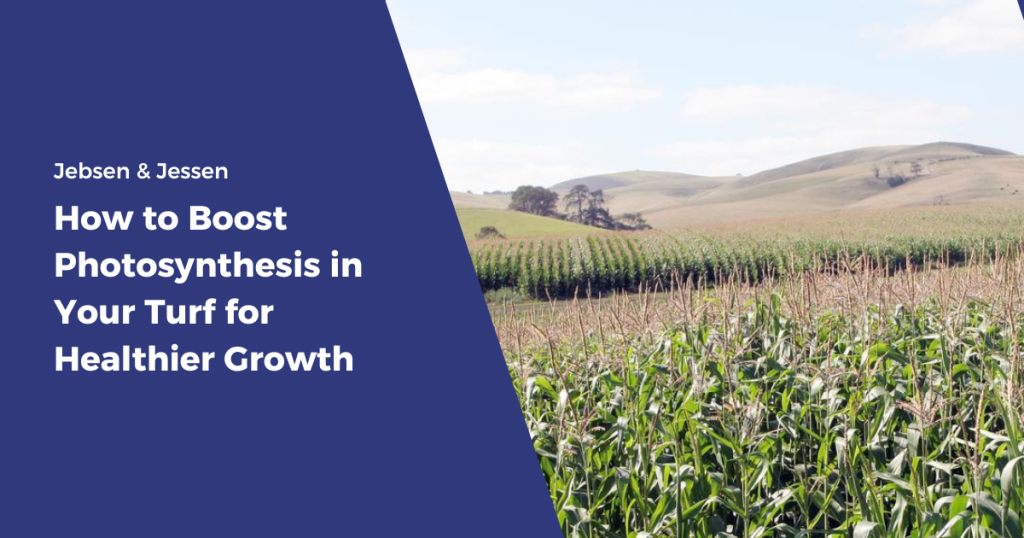Lush, green, envy-inducing turf is the mark of a beautiful landscape. But beneath that flawless carpet of grass is a complex living system powered by the process of photosynthesis. Unlocking the secrets behind optimizing photosynthesis is key to growing thick, healthy, resilient turf.
Photosynthesis — the intricate biochemical process that converts sunlight, carbon dioxide, and water into plant fuel — makes turf growth possible. The more efficient this solar-powered operation, the more energy is devoted to the traits we desire in turfgrass: rapid growth, deep green color, disease resistance, and recovery from traffic. Mastering the science and art of enhancing photosynthesis allows turf managers to harness the full genetic potential of today’s turf varieties.
This article explores the fundamentals of photosynthesis and provides science-based, best-practice tips for maximizing this essential process in your turf. Discover how paying attention to light, moisture, nutrients, and environmental conditions gives you the power to boost photosynthetic performance for a championship-worthy playing surface.
What is Photosynthesis, and Why is it Important?
Photosynthesis is the process plants use to convert sunlight, carbon dioxide, and water into energy and oxygen. It allows plants to grow and thrive by producing carbohydrates, their own food source.
For turfgrass, photosynthesis is especially critical as it impacts:
- Growth rate
- Recovery from damage
- Color and appearance
- Stress tolerance
- Overall plant health
Simply put, optimizing photosynthesis results in healthier, more resilient turf.
Chlorophyll, the green pigment in plants, absorbs light energy, which drives the photosynthetic process. The more efficient this process is, the more energy the plant can devote to optimal growth and performance.
Factors that Influence Turf Photosynthesis
Sunlight Availability
Sunlight provides the energy that fuels photosynthesis through photosynthetically active radiation (PAR). Turfgrass thrives with a minimum of 6-8 hours of direct sunlight daily. Sites with limited sun exposure exhibit telltale signs of reduced photosynthetic activity:
- Slowed vertical growth and lateral spread
- Thinner, sparse turf with more weeds
- Pale green or yellowish color
- Decline in shoot density and tillering
- Increased susceptibility to pests and diseases
Proper mowing practices help ensure adequate light exposure. Maintaining proper mowing height distributes leaves vertically for better light interception. Changing mowing patterns prevents matted layers and allows light to reach lower leaves. Removing tree limbs and pruning properly prevents excessive shading.
Water Supply
Water is essential for photosynthesis. It acts as an electron donor, provides structure to chloroplasts, and cools leaf surfaces. Dehydration causes stomates to close, severely limiting the gas exchange necessary for photosynthesis.Drought conditions impede water and nutrient movement within the plant. This negatively affects chlorophyll production, enzyme function, and the Calvin cycle reactions. Adequate irrigation through proper soil moisture monitoring and scheduling is critical, especially for turf in hot, sunny climates.
Nutrient Availability
Macronutrients like nitrogen, phosphorus, and potassium are needed for chlorophyll synthesis and the structure of the photosynthetic machinery. Micronutrients serve as metal cofactors in enzymatic reactions and chlorophyll production. Deficiencies impair metabolic pathways, reducing photosynthetic capacity.
Soil testing reveals nutritional status. Fertilization and pH adjustment ensure turfgrass has a readily available nutrient pool for peak photosynthetic activity. Controlled-release fertilizers provide steady nutrition without loss of volatilization or leaching.
Environmental Conditions
Temperature, humidity, soil pH, compaction, thatch buildup, and other environmental factors all influence photosynthetic rates. Each turfgrass species has an optimum temperature range for photosynthesis. Enzymes work less efficiently outside this range.
Low soil pH creates micronutrient deficiencies as minerals become less available. Compacted or thatchy layers prevent roots from adequately accessing water and nutrients. While we can’t control the weather, optimizing these factors where possible provides a favorable environment for photosynthesis.
Tips to Maximize Photosynthesis in Turf
Turf managers can take several proactive steps to create optimal growing conditions that enhance the photosynthetic capacity of their turfgrass.1. Ensure Adequate Sunlight Exposure

- When establishing a new lawn or overseeded area, select a site with a minimum of 6-8 hours of direct sun exposure daily. Avoid excessive shade from buildings, trees, fences, or other structures. Selecting sites with ample sun exposure allows turfgrass to absorb maximum light energy to power photosynthesis. This results in improved growth rate, density, and color.
- For cool-season grasses, raise the mowing height to the upper end of the recommended range for that species. A height of 3-4 inches allows more leaf surface area to intercept sunlight. Raising mowing height provides more leaf surface area to intercept sunlight. Taller blades mean more chlorophyll for absorbing light energy. This enhances photosynthetic capacity.
- Mow in different directions with each cutting to prevent matted layers and allow light to reach lower leaves. Routine vertical mowing also helps in this regard. Changing mowing patterns distributes sunlight evenly to prevent shaded, weak spots. Light interception is optimized for greater productivity.
- Avoid scalping or removing more than 1/3 of the leaf blade with any mowing. This will prevent stress and thinning, allowing leaves to remain healthy and active in photosynthesis.
- For chronically shaded areas, choose shade-tolerant varieties like fine fescues. Supplement with routine broadleaf weed control and strategic fertilization to optimize growth.
2. Maintain Optimal Soil Moisture Levels
- Irrigate deeply and infrequently to encourage deeper rooting, which enhances access to water and nutrients. Target 1-1.5 inches per week. Deep, infrequent irrigation encourages expansive root systems for better moisture and nutrient uptake, providing a strong foundation for photosynthesis.
- Time watering for early morning hours between 4-8 am to reduce evaporation loss. Avoid evening watering. Irrigating in the early morning minimizes water loss to evaporation. Adequate moisture retained in the soil keeps photosynthetic tissues hydrated.
- Install an in-ground irrigation system with proper spacing and controllers for adequate and uniform water coverage. Automated irrigation provides uniform coverage and easy scheduling adjustments. Consistent moisture optimizes photosynthetic enzyme activity.
- Adjust schedules seasonally based on average rainfall and temperature patterns. Reduce irrigation in cooler months. Adjusting watering for seasonal changes avoids over/under-watering. Soil moisture is kept in the ideal range for photosynthesis.
3. Provide a Complete Nutrient Package
- Perform annual soil tests to identify nutritional deficiencies. Apply lime if needed to correct the pH between 6.5 and 7. Soil testing identifies deficiencies limiting photosynthetic processes. Corrective fertilization relieves nutrient constraints on chlorophyll synthesis and enzyme function.
- Look for a controlled-release fertilizer that provides NPK, sulfur, magnesium, and a broad spectrum of essential micronutrients. Balanced fertilization with micronutrients supplies turfgrass with all the required mineral elements to build photosynthetic machinery and maximize activity.
- Specialized products like MicroBooster 0-0-1 deliver zinc, manganese, copper, iron, boron, and molybdenum to maximize chlorophyll production and photosynthetic activity. This all-in-one micronutrient package powers energy production and photosynthesis through enhanced chlorophyll synthesis and efficiency.
Sea kelp extracts in MicroBooster 0-0-1 provide growth-promoting cytokinins to stimulate chlorophyll development. Amino acids, vitamins, and patented CarbCatalystsTM round out the formulation by energizing carbon utilization and the Calvin cycle reactions. By supplying this complete micro-package, MicroBooster boosts the biochemical conversion of light energy into plant fuel. It is labeled for use on all cool and warm-season grasses to transform turf into a photosynthetic powerhouse. Apply MicroBooster 0-0-1 according to directions to maximize photosynthetic capacity and unlock genetic potential all season long.
- Stick to recommended application rates and intervals for steady nutrient availability, according to soil analysis results. Timed fertilization ensures the continuous availability of mineral nutrients, ensuring that photosynthetic tissues have constant access to necessary elements.
4. Optimize Environmental Conditions
- During heat spells, syringe turf leaves with cool water to lower tissue temperature and prevent wilting, which closes stomates.
- Allow the soil to dry briefly between irrigations to promote deeper roots and improved nutrient uptake. Periodic drying encourages deeper roots for better access to water and minerals. Improved plant hydration and mineral absorption bolster photosynthesis.
- Aerate compacted areas and rake out thatch buildup to enhance air and water movement to roots. Aeration relieves compaction and improves drainage. Better gas exchange and root function enhance photosynthetic rates.
- Use turf covers to protect grass from extreme cold and heat and improve drainage in poorly draining sites. Protective covers buffer grass from temperature extremes that slow photosynthesis. Covers optimize light reception and minimize desiccation.




